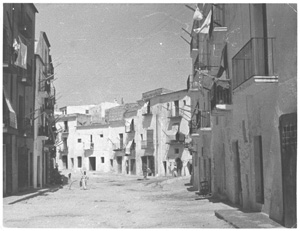|
The music of the Pityusan Islands, Ibiza and Formentera, has been the subject of some speculation, but few serious studies. The recent extensive volume on Catalan and Balearic music includes only a few paragraphs and scattered mentions of the Pityusan Islands (Aviñoa). Alan Lomax’s 1952 recordings, which we are in the process of editing for a CD release (1), may constitute the first systematic field recordings of the islands. The first important fieldwork excursion was that of Baltasar Samper in the 1920s, published with musical transcriptions and a detailed field diary, which have recently been re-edited (see Massot IX). Later, the fundamental work of Isidor Macabich included a substantial collection of songs, some with musical transcriptions. Other studies are listed in the bibliography (2). Studies have focussed almost exclusively on rural traditions, which are seen as emblematic of Pityusan traditional culture. The few exceptions deal mostly with band and chorus music and religious music (see Torres i Peters).
|
2. Background
|
A very brief account of historical and social contexts is important to understanding music in the Pityusan (“Pine Tree”) Islands, Ibiza (Eivissa) and Formentera . While administratively they form part of the Autonomy of the Balearic Islands together with Mallorca and Minorca, they are very different from the latter islands. Pityusan Catalan, which Ibizans call ibicenco or eivissenc, has many archaic features and intriguing quirks, some but by no means not all of which are shared by Mallorcan Catalan. Many country people (pagesos, sing. pagès, pagesa) still speak Castilian only if necessary and often with difficulty. The music of the Pityusan Islands is entirely different from that of Mallorca and Minorca. In fact, a recent study concluded that the Pityusans form an identifiably different genetic group from the other two islands (4). Ibiza and Formentera have a long and varied history of conquests and settlements, from the Phoenicians in the seventh century B.C.E., with whom they still claim cultural and even genetic links, through Greek, Roman, Muslim, and Catalan rule, not forgetting the continuing Jewish presence from the Phoenician time onwards (5). The islands’ location between the Iberian Peninsula and North Africa is a strategic one, and “white gold”, the salt pans set up by the Phoenicians and still active 3000 years later, was central to Pityusan economy for centuries, leading as well to the “salt route” which brought the islands into contact with many cultures. The Phoenician goddess Tanit, protector of fertility, appears in many archeological remains, as does Bes, the Egyptian god associated with dance and music, who gave Ibiza its name. The Pityusans’ strategic location also meant centuries of ongoing invasions and attacks by sea pirates. A tradition of corsairs battling the pirates lasted centuries, and at the same time the islanders developed a fierce attachment to arms. Formentera, smaller, flatter and much more difficult to defend, was depopulated from the fourteenth to the eighteenth century, when it was repopulated from Ibiza. The Pityusans are full of these and other contradictions. They are a strong, practical, self-sufficient sea people, with a history of pirates and corsairs battling on the high seas, and at the same time what seems to be a longtime, almost comfortable coexistence with mythological creatures such as the barruguet, magic well spaces and other apparently pre-Christian beliefs and practices. These have been appropriated, re-mythologized, and to some extent commercialized by hippie and tourism cultures, but on another, deeper level, they remain part of many Pityusan islanders’ daily inner lives. |
